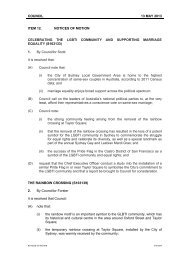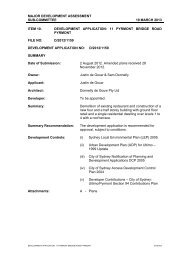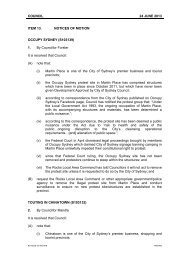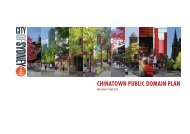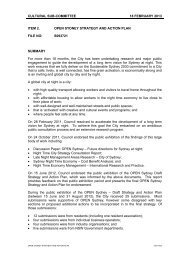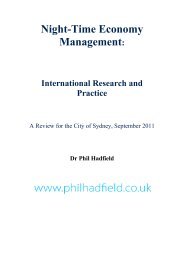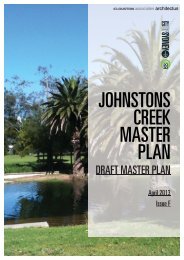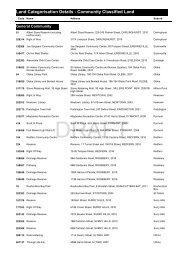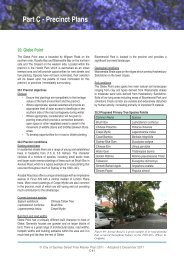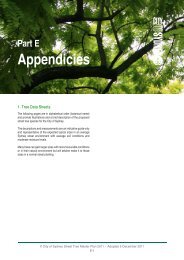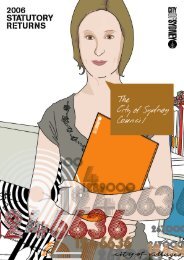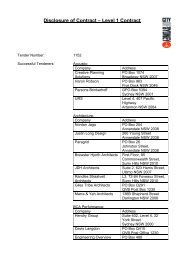Histories of Green Square - City of Sydney
Histories of Green Square - City of Sydney
Histories of Green Square - City of Sydney
Create successful ePaper yourself
Turn your PDF publications into a flip-book with our unique Google optimized e-Paper software.
Chapter 4 – Chimneys and Change<br />
Chapter 4 Chimneys and Change:<br />
Post-European environmental<br />
impact in <strong>Green</strong> <strong>Square</strong><br />
4.1 Introduction: the larger wetland environment<br />
The <strong>Green</strong> <strong>Square</strong> area is best understood as part <strong>of</strong> a larger<br />
environmental space. From the heights <strong>of</strong> Paddington and<br />
Bondi Junction in the northeast, water has traditionally run<br />
through a series <strong>of</strong> ponds, marshes, swamps and creeks down<br />
to Botany Bay, in the southwest. The areas <strong>of</strong> Waterloo, Alexandria,<br />
Zetland and Rosebery are bound up with this larger<br />
wetland environment and lie at an intermediate point in this<br />
chain <strong>of</strong> water catchment and run-<strong>of</strong>f. The character <strong>of</strong> the<br />
area as a natural water reservoir and drainage corridor, has<br />
had far reaching consequences for human exploitation and<br />
activity in the area since 1788.<br />
Dramatic environmental change has resulted from this<br />
human usage, and the specific environment <strong>of</strong> <strong>Green</strong> <strong>Square</strong>,<br />
is best explored within the context <strong>of</strong> this larger environmental<br />
story.<br />
4.2 Early European observations <strong>of</strong> the area<br />
Thomas Woore made detailed observations in a letter to the<br />
President <strong>of</strong> the Commission <strong>of</strong> Inquiry into the supply <strong>of</strong><br />
© Scott Cumming<br />
Scott Cumming<br />
water to <strong>Sydney</strong>, in 1869. His comments provide an insight<br />
into the great environmental changes that took place in<br />
this area between 1829 and 1869. Woore visited ‘the Botany<br />
swamps’ in 1829, 1833, 1834 and again in 1869. His sketch <strong>of</strong><br />
the Waterloo Mills in 1833 shows the structure standing on<br />
the edge <strong>of</strong> an extensive marsh.<br />
By 1869, though, Woore reported that great changes had taken<br />
place. The once copious stream had almost ceased to flow, the<br />
aquatic plant life had gone and an equestrian could ride over<br />
any part <strong>of</strong> what was originally a fluid morass. The area had<br />
become ‘…a tract <strong>of</strong> barren sandhills that immediately the<br />
rain descends on them, rushes to the sea in torrents’. 1<br />
The activity <strong>of</strong> settlers had wrought these dramatic changes.<br />
The limited timbers were cleared for the purposes <strong>of</strong> construction<br />
or for use as firewood. The lower scrub was cleared to allow<br />
for the grazing <strong>of</strong> cattle and horses, whose tramping hooves<br />
further hardened the ground surface. Areas <strong>of</strong> marshland were<br />
deliberately drained to facilitate the establishment <strong>of</strong> market<br />
gardens or to channel the water itself, for use, for example, in<br />
the powering <strong>of</strong> steam mills.<br />
Fig. 4.1 Upper Dam, Hinchcliff’s Waterloo Mills wool washing establishment.<br />
(Source: Town and Country Journal, 16 June 1877, courtesy Mitchell Library, State Library <strong>of</strong> NSW.)<br />
31



